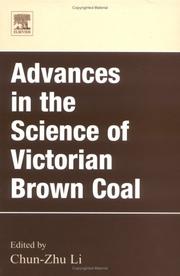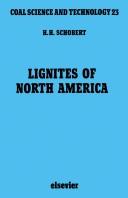| Listing 1 - 10 of 19 | << page >> |
Sort by
|

ISBN: 9780080526447 0080526446 1281410667 9781281410665 0080442692 9780080442693 9786611410667 Year: 2004 Publisher: London Elsevier
Abstract | Keywords | Export | Availability | Bookmark
 Loading...
Loading...Choose an application
- Reference Manager
- EndNote
- RefWorks (Direct export to RefWorks)
Over the past decade, extensive research has been conducted on the subject of coal as one of the world's leading energy sources. The current and future status of this resource is a topic of considerable interest to the largest world economies, including the US, Japan, China and Europe. Advances in the Science of Victorian Brown Coal provides critical reviews of the information and research published over this time, giving the reader an authoritative overview of the science surrounding this important topic.· Critical review of recent research surrounding the utilizati
Book
ISBN: 3110729962 Year: 2022 Publisher: Berlin, Germany : Walter de Gruyter GmbH,
Abstract | Keywords | Export | Availability | Bookmark
 Loading...
Loading...Choose an application
- Reference Manager
- EndNote
- RefWorks (Direct export to RefWorks)
Lignite industry --- Lignite --- History --- Industrie --- Histoire --- National socialism. --- History.
Book
ISBN: 1523104031 1849952752 9781849952750 Year: 2016 Publisher: Whittles Publishing
Abstract | Keywords | Export | Availability | Bookmark
 Loading...
Loading...Choose an application
- Reference Manager
- EndNote
- RefWorks (Direct export to RefWorks)
A thorough international review of all aspects of lignites, including the essential topics of CO2 emissions and carbon capture and storage.
Lignite --- Brown coal --- Coal --- Fuel --- Testing.
Book
ISBN: 1628086645 9781628086645 9781628086638 1628086637 Year: 2013 Publisher: Hauppauge, New York
Abstract | Keywords | Export | Availability | Bookmark
 Loading...
Loading...Choose an application
- Reference Manager
- EndNote
- RefWorks (Direct export to RefWorks)
Charcoal is a light black residue consisting of carbon, and any remaining ash, obtained by removing water and other volatile constituents from animal and vegetation substances. In this book, the authors discuss the chemical properties, production methods and applications of charcoal. Topics include the obtention of charcoal from eucalyptus wood in a steel pilot scale kiln; application of carbon-supported metal catalysts in the field of hydrodechlorination; emission reduction theory and results in the development of a suitable small-scale, portable, continuous rice husk carboniser for rural reg
Charcoal. --- Carbonization. --- Coal --- Coke --- Distillation, Destructive --- Lignite --- Carbon --- Carbonization --- Fuel

ISBN: 9780444898234 0444898239 9780080544625 0080544622 1281060054 9781281060051 9786611060053 Year: 1995 Publisher: Amsterdam ; New York : Elsevier,
Abstract | Keywords | Export | Availability | Bookmark
 Loading...
Loading...Choose an application
- Reference Manager
- EndNote
- RefWorks (Direct export to RefWorks)
Providing a comprehensive survey of the origin, the fundamental properties, and the technology of utilization of the lignites of North America, this book will be of particular interest to professional scientists and engineers working in coal research or coal technology. Coals display a continuum of properties, often with no sharp, steep change between ranks and thus the book restricts the discussion strictly to lignites (with the occasional comparisons with other coals). There is a very extensive index, making the contents of the book easily accessible to the reader.
Lignite --- Coal --- Caustobioliths --- Fossil fuels --- Brown coal --- Fuel
Book
ISBN: 0081009291 0081008953 9780081009291 9780081008959 Year: 2017 Publisher: Duxford, United Kingdom : Woodhead Publishing,
Abstract | Keywords | Export | Availability | Bookmark
 Loading...
Loading...Choose an application
- Reference Manager
- EndNote
- RefWorks (Direct export to RefWorks)
This book provides a thorough introduction to lignite (brown coal) and subbituminous coals and explores how they can be used efficiently and economically in place of hard coal.
Lignite. --- Subbituminous coal. --- Brown coal --- Coal --- Fuel --- Black lignite (Subbituminous coal) --- Lignitic coal (Subbituminous coal) --- Sub-bituminous coal
Book
Year: 2021 Publisher: Basel, Switzerland MDPI - Multidisciplinary Digital Publishing Institute
Abstract | Keywords | Export | Availability | Bookmark
 Loading...
Loading...Choose an application
- Reference Manager
- EndNote
- RefWorks (Direct export to RefWorks)
It is widely believed that a large proportion of greenhouse gas emissions originated anthropogenically from the use of fossil fuels with additional contributions coming from manufactured materials, deforestation, soil erosion, and agriculture (including livestock). The global society actively supports measures to create a flexible and low-carbon energy economy to attenuate climate change and its devastating environmental consequences. In this Special Issue, the recent advancements in the next-generation thermochemical conversion processes for solid fuels and renewable energies (e.g., the operational flexibility of co-combustion of biomass and lignite, integrated solar combined cycle power plants, and advanced gasification systems such as the sorption-enhanced gasification and the chemical looping gasification) were shown.
hydrochar --- hydrothermal carbonization --- biogas upgrading --- CO2 capture --- pressure swing adsorption --- gasification --- kinetic model --- conversion model --- reaction model --- low-rank coal --- tar absorption --- process simulation --- validation study --- sensitivity analyses --- lignite --- lignite gasification --- fluidized-bed gasifier --- olivine --- solar cooling --- solar cooling system --- TRNSYS --- absorption chiller --- performance and analysis --- solar energy --- chemical looping --- biomass gasification --- process control --- CO2 absorption --- experimental study --- energy analysis --- exergy analysis --- CSP --- PTC --- ISCC --- power plant --- CFB combustion --- operational flexibility --- load transients --- fluctuating electricity generation --- renewables --- one-dimensional SEG model --- dual fluidized bed --- sorbent deactivation --- hydrodynamics --- kinetics --- fuel feeding rate --- biomass --- thermochemical conversion technologies --- combustion --- carbon capture and storage/utilization --- solar-driven air-conditioning --- integrated solar combined cycle --- energy and exergy analyses --- thermodynamic modeling --- dynamic process simulation
Book
ISBN: 3039215345 3039215353 Year: 2019 Publisher: MDPI - Multidisciplinary Digital Publishing Institute
Abstract | Keywords | Export | Availability | Bookmark
 Loading...
Loading...Choose an application
- Reference Manager
- EndNote
- RefWorks (Direct export to RefWorks)
The rapid growth of global energy consumption and simultaneous waste discharge requires more sustainable energy production and waste disposal/recovery technology. In this respect, microbial fuel cell and bioelectrochemical systems have been highlighted to provide a platform for waste-to-energy and cost-efficient treatment. Microbial fuel cell technology has also contributed to both academia and industry through the development of breakthrough sustainable technologies, enabling cross- and multi-disciplinary approaches in microbiology, biotechnology, electrochemistry, and bioprocess engineering. To further spread these technologies and to help the implementation of microbial fuel cells, this Special Issue, entitled “Microbial Fuel Cells 2018”, was proposed for the international journal Energies. This Special Issue mainly covers original research and studies related to the above-mentioned topic, including, but not limited to, bioelectricity generation, microbial electrochemistry, useful resource recovery, system and process design, and the implementation of microbial fuel cells.
biogenic conversion --- power density --- treatment efficiency --- microbial fuel cell (MFC) --- flow rate --- hydrogen production --- bioelectrochemical system --- C1 gas --- acetate --- bioelectrochemical reactor --- TiO2 nanotube --- environmental engineering --- lignite --- dye decolorization --- electrodialysis --- Ni–Co alloy --- dilution rate --- substrate supply rate --- carbon monoxide --- inhibition --- microbial fuel cell --- acetosyringone --- anodic volume --- microbial electrolysis cell --- syringaldehyde --- laccase --- methane --- anode distance --- coal --- power generation --- yeast wastewater --- cathode --- renewable energy source --- natural redox mediators
Book
Year: 2020 Publisher: Basel, Switzerland MDPI - Multidisciplinary Digital Publishing Institute
Abstract | Keywords | Export | Availability | Bookmark
 Loading...
Loading...Choose an application
- Reference Manager
- EndNote
- RefWorks (Direct export to RefWorks)
The development of porous materials has attracted the attention of the research community for years. Porosity characteristics have specific impacts on the material properties and materials that are applied in many areas, such as pollutant removal, CO2 capture, energy storage, catalytic oxidation and reduction processes, the conversion of biomass to biofuels, and drug delivery. Examples of porous materials are activated carbons, clays, and zeolites. The aim of this book is to collect the recent advances and progress regarding porous materials and their applications in the environmental area.
spherical seeds --- spherical activated carbons --- activation --- microporosity --- mechanical properties --- diatomite --- zeolite X --- hydrothermal method --- calcium ion exchange capacity --- clay minerals particles --- orientational anisotropy --- granular systems --- disk packing --- X-Ray microtomography --- mesoscale simulation --- water produced --- adsorbent materials --- composite --- AlFe-pillared clay --- CrCeOx --- chlorobenzene --- catalytic combustion --- temperature-programmed reaction --- lignite --- porous structure --- carbon dioxide --- pressure --- CuCl/AC adsorbent --- CO adsorption --- monolayer dispersion --- isosteric heat --- adsorption isotherms --- Fischer–Tropsch --- supported iron oxide --- supported cobalt oxide --- reducibility --- dispersion --- biosorption --- weed --- methylene blue dye --- natural biosorbents --- adsorption kinetics
Book
ISBN: 3036560122 3036560114 Year: 2022 Publisher: Basel MDPI - Multidisciplinary Digital Publishing Institute
Abstract | Keywords | Export | Availability | Bookmark
 Loading...
Loading...Choose an application
- Reference Manager
- EndNote
- RefWorks (Direct export to RefWorks)
The present book contains nine articles that were accepted and published in the Special Issue “Modeling and Control of Energy Conversion during Underground Coal Gasification Process” of the MDPI Energies journal. This book focuses on the energy conversion processes in underground coal gasification (UCG), as well as on the modeling and control of this process. The articles published in this book can be divided into three thematic parts of research in the field of underground coal gasification technology: the first part is the impact of technology on the environment, the second is research (studies) on the coal areas and coal properties of UCG technology, and the third is the monitoring, modeling, and control processes within UCG. We hope that this book will be interesting and useful for workers and researchers in the field of underground coal gasification technology, as well as for those who are interested in the mathematical modeling and control of this process.
Technology: general issues --- History of engineering & technology --- low-carbon energy --- UCG technology --- grouting --- solidification soil --- soil air --- statistic model --- soil contamination --- atmospheric geochemical survey --- environmental burden --- underground coal gasification (UCG) --- optimization --- syngas --- calorific value --- optimal control --- operating variables --- control algorithm --- coal gasification --- rocks --- coal seam --- material balance --- heat balance --- tightness --- gas --- underground coal gasification --- georeactor --- char --- melted waste rock --- gas permeability --- tortuosity --- porosity --- measurement --- temperature --- regression --- model --- analyses --- cavity --- lignite --- UCG --- ex situ tests --- high temperature --- strength and structural parameters of rocks after heating --- destruction zone around gasified channel --- SNG --- UCG wastewater --- environmental impact assessment --- correlation analysis --- effluents --- n/a
| Listing 1 - 10 of 19 | << page >> |
Sort by
|

 Search
Search Feedback
Feedback About UniCat
About UniCat  Help
Help News
News